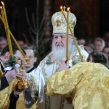
Moscow Patriarchate Expands Missionary Work among Non-Russians, Setting the Stage for Conflicts with Muslim Nations
Publication: Eurasia Daily Monitor Volume: 10 Issue: 24
By:

One of the least noted aspects of the just completed meeting of the leadership of the Moscow Patriarchate of the Russian Orthodox Church may prove to be the most significant and explosive of all. In his speech to the Sobor, a formal gathering of Orthodox Church leadership and clergy, Patriarch Kirill suggested that he is ready to dramatically expand missionary work inside the Russian Federation. First the Church will seek to proselytize to peoples of the Far North, many of whom remain animist and whom the leaders of traditional religious communities of Russia consider fair game for missionary work. And then it will actively minister to those who are members of ethnic groups that are traditionally members of another of Russia’s recognized traditional faiths, including Islam (raipon.info/component/content/article/1-novosti/3862-2013-02-03-13-05-33.html).
Since the end of Soviet times, the leaders of the four so-called “traditional” religions of the Russian Federation—Russian Orthodoxy, Islam, Judaism and Buddhism—have frequently said that none of them should seek to convert members of the others. But over the last several years, the Moscow Patriarchate has laid the groundwork for launching a broader missionary program. This is both because Moscow has been alarmed by the growth of other denominations, including Protestants, and because the Kremlin increasingly relies on the Russian Orthodox Church, which claims to speak for 80 percent of that country’s population, to legitimize official government actions.
The Orthodox Church’s broadening activity has taken two forms. On the one hand, a limited number of priests have openly conducted missionary work among people they call “ethnic Muslims,” that is, members of traditionally Muslim nationalities, but who do not practice their faith. Their activities have been controversial, and at least one of the priests involved was killed, supposedly by Islamic radicals. And on the other, the Patriarchate, since 2009, has set up special missionary sites in various parts of the country, first and foremost in the Russian Far North, in the hopes of winning converts and boosting the Orthodox share of the population.
Because this second effort has attracted little attention, few have recognized that it may be the more important because it suggests that Patriarch Kirill wants to revive the 19th century Ilminsky system that the Church used in imperial times as part of its effort to convert Muslims. While that education-based system is known today primarily for its work in promoting literacy and creating alphabets for many of the Muslim nationalities of the Russian Empire, it did result in the conversion of some Muslims and—what may be of most interest now—promoted the formation of the Kryashens, a sub-group of baptized Kazan Tatars, The Russian Federation in recent years has seen them as an important tool to reduce the population size and hence influence of the Tatars, currently the second largest nationality in the Russian Federation.
Earlier this week, Kirill declared: “Speaking at the last Sobor [in 2009], I supported the idea of establishing missionary posts in the bishoprics of the North and Far East. In the inter-Sobor period, a project of the typical building of a missionary site for regions of the Far North was developed, and work on their erection was begun. Synod missionaries were sent on long-term missionary expeditions to the Far Eastern bishoprics [of the Church] and agreements regulating cooperation in the sphere of the organization of missionary sites and the conduct of missionary expeditions were concluded.” He added that this “direction must remain one of the priority directions” in the life of the Church (raipon.info/component/content/article/1-novosti/3862-2013-02-03-13-05-33.html).
Those rather anodyne words, particularly because they involve peoples who number only about one percent of the Russian population now, could be passed over in silence, as the patriarch probably intended, were it not for two other publications that also appeared this week. The first of these celebrated the work of Metropolitan Nestor, an Orthodox missionary at the end of the Imperial period in Kamchatka (www.russdom.ru/node/5727), and the second, even more significant, welcomed the return to Orthodoxy of an ethnic Azeri who had been Muslim earlier (ruskline.ru/analitika/2013/02/07/ya_vernulsya_k_vere_predkov/). Both articles appeared on websites close to the Orthodox Church.
Any moves to expand Orthodox missionary work beyond the North will beyond doubt increase tensions among the leaders and followers of Russia’s traditional faiths, most importantly, between the Orthodox Christians and Muslims. But such moves will also lead some to consider the impact of Nikolay Ilminsky (1822–1891) on ethnic relations in the Russian Empire. Based in Kazan and with the support of the reactionary Procurator Konstantin Pobedonostev, Ilminsky developed language systems and helped convert many in the Middle Volga, Siberia as well as Central Asia, even as he backed highly restrictive policies against nationalities there.
And that too may be one of the reasons Kirill is moving in this somewhat unexpected direction, because, as scholar Isabelle Kreindler pointed out 35 years ago, Ilminsky’s approach—cultural development combined with conversion to Orthodoxy and harsh restrictions on non-Russians—was “a neglected source of Lenin’s nationality policy” (Slavic Review 36 (1977): 86–100).




